David Keys
Source - http://www.independent.co.uk/news/science/archaeology/features/the-biggest-wonder-about-the-hanging-gardens-of-babylon-they-werent-in-babylon-8604649.html
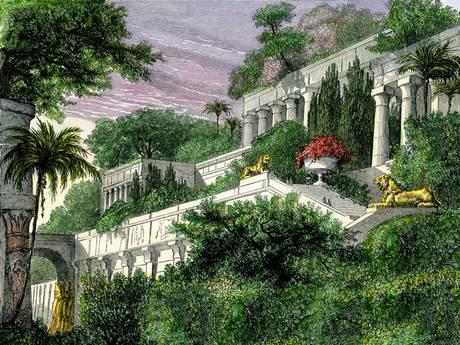
North Wind Picture Archives / Alamy
The Hanging Gardens of Babylon, one of the Seven Wonders of the Ancient World, weren’t in Babylon at all – but were instead located 300 miles to the north in Babylon’s greatest rival Nineveh, according to a leading Oxford-based historian. After more than 20 years of research, Dr. Stephanie Dalley, of Oxford University’s Oriental Institute, has finally pieced together enough evidence to prove beyond reasonable doubt that the famed gardens were built in Nineveh by the great Assyrian ruler Sennacherib - and not, as historians have always thought, by King Nebuchadnezzar of Babylon. Dr. Dalley first publicly proposed her idea that Nineveh, not Babylon, was the site of the gardens back in 1992, when her claim was reported in The Independent – but it’s taken a further two decades to find enough evidence to prove it.
Detective work by Dr. Dalley – due to be published as a book by Oxford University Press later this month – has yielded four key pieces of evidence.
First, after studying later historical descriptions of the Hanging Gardens, she realized that a bas-relief from Sennacherib’s palace in Nineveh actually portrayed trees growing on a roofed colonnade exactly as described in classical accounts of the gardens.
That crucial original bas-relief appears to have been lost in the mid 19 century. When it was discovered by the British archaeologist, Austin Henry Layard, in the 1840s, it seems to have already been in such poor condition that its surface was, in all probability, rapidly crumbling away. Alternatively, it may have been amongst a group of Layard’s UK- bound Nineveh carvings which were lost when the boat carrying them sank in the River Tigris. Luckily, however, an artist employed by Layard had already drawn the bass-relief – and that drawing, recently recognised by Dr. Dalley as portraying the garden, had been reproduced in Layard’s book about Nineveh published in London in 1853.
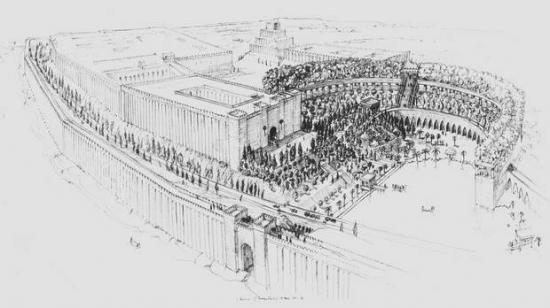
An artist’s impression of what the Hanging Gardens at Nineveh would have looked like c700BC Terry Ball / Stephanie Dalley
Further research by Dr. Dalley then suggested that, after Assyria had sacked and conquered Babylon in 689 BC, the Assyrian capital Nineveh may well have been regarded as the ‘New Babylon’ – thus creating the later belief that the Hanging Gardens were in fact in Babylon itself. Her research revealed that at least one other town in Mesopotamia - a city called Borsippa – was being described as “another Babylon” as early as the 13 century BC, thus implying that in antiquity the name could be used to describe places other than the real Babylon. A breakthrough occurred when she noticed from earlier research that after Sennacherib had sacked and conquered Babylon, he had actually renamed all the gates of Nineveh after the names traditionally used for Babylon’s city gates. Babylon had always named its gates after its gods. After the Assyrians sacked Babylon, the Assyrian monarch simply renamed Nineveh’s city gates after those same gods. In terms of nomenclature, it was clear that Nineveh was in effect becoming a ‘New Babylon’.
Dr. Dalley then looked at the comparative topography of Babylon and Nineveh and realized that the totally flat countryside around the real Babylon would have made it impossible to deliver sufficient water to maintain the sort of raised gardens described in the classical sources. As her research proceeded it therefore became quite clear that the ‘Hanging Gardens’ as described could not have been built in Babylon. Finally her research began to suggest that the original classical descriptions of the Hanging Gardens had been written by historians who had actually visited the Nineveh area.
Researching the post-Assyrian history of Nineveh, she realized that Alexander the Great had actually camped near the city in 331BC – just before he defeated the Persians at the famous battle of Gaugamela. It’s known that Alexander’s army actually camped by the side of one of the great aqueducts that carried water to what Dr. Dalley now believes was the site of the Hanging Gardens.
Alexander had on his staff several Greek historians including Callisthenes, Cleitarchos and Onesicritos, whose works have long been lost to posterity – but significantly those particular historians’ works were sometimes used as sources by the very authors who several centuries later described the gardens in works that have survived to this day.
“It’s taken many years to find the evidence to demonstrate that the gardens and associated system of aqueducts and canals were built by Sennacherib at Nineveh and not by Nebuchadnezzar in Babylon. For the first time it can be shown that the Hanging Garden really did exist” said Dr. Dalley.
The Hanging Gardens were built as a roughly semi-circular theatre-shaped multi-tiered artificial hill some 25 metres high. At its base was a large pool fed by small streams of water flowing down its sides. Trees and flowers were planted in small artificial fields constructed on top of roofed colonnades. The entire garden was around 120 metres across and it’s estimated that it was irrigated with at least 35,000 litres of water brought by a canal and aqueduct system from up to 50 miles away. Within the garden itself water was raised mechanically by large water-raising bronze screw-pumps.
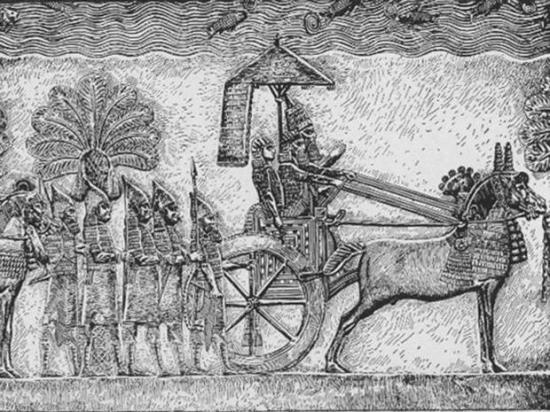
The Assyrian ruler Sennacherib, pictured in the chariot, in a bas-relief from his grandson’s palace, which depicts the gardens - Stephanie Dalley
The newly revealed builder of the Hanging Gardens, Sennacherib of Assyria - and Nebuchadnezzar of Babylon who was traditionally associated with them - were both aggressive military leaders. Sennacherib’s campaign against Jerusalem was immortalized some 2500 years later in a poem by Lord Byron describing how “the Assyrians came down like a wolf on the fold,” his cohorts “gleaming in purple and gold.”
Both were also notorious for destroying iconic religious buildings. Nebuchadnezzar of Babylon destroyed Solomon’s Temple in Jerusalem and according to one much later tradition was temporarily turned into a beast for his sins against God. Sennacherib of Assyria destroyed the great temples of Babylon, an act which was said to have shocked the Mesopotamian world. Indeed tradition holds that when he was later murdered by two of his sons, it was divine retribution for his destruction of those temples.
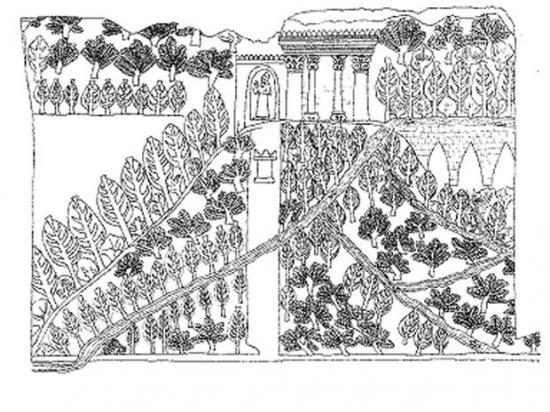
Drawing of a bas-relief from the palace of Sennacherib’s grandson in Nineveh, showing what is now believed to have been the Hanging Gardens - Stephanie Dalley
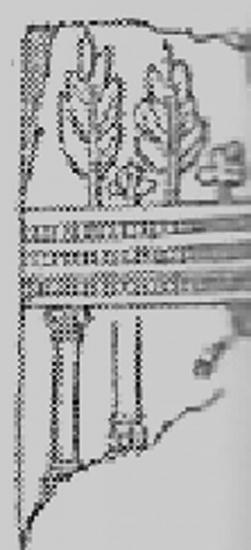
A mid-19th century drawing of part of a now long-lost fragment of a bas-relief from Sennacherib’s palace in Nineveh showing trees growing on top of a roofed colonnade, exactly as described in later descriptions of the Hanging Gardens
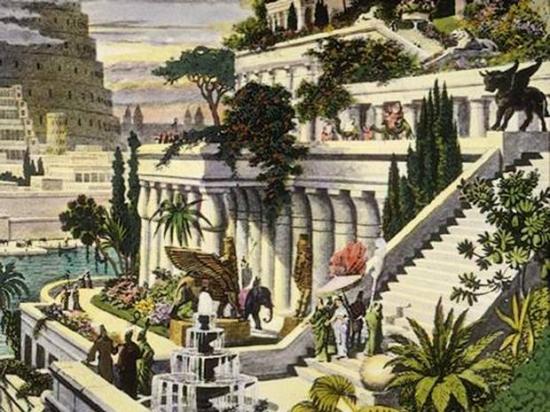
Traditional early modern and later perception of what the Hanging Gardens of Babylon looked like. This 16th-century hand-coloured engraving of the Hanging Gardens of Babylon was drawn by the Dutch artist Maarten van Heemskerck – interestingly with the Tower of Babel in the background
Bizarrely it may be that the Hanging Gardens were the first of the seven ‘wonders’ of the world to be so described – for Sennacherib himself referred to his palace gardens, built in around 700BC or shortly after, as “a wonder for all the peoples”. It’s only now however that the new research has finally revealed that his palace gardens were indeed one of the Seven Wonders of the Ancient World. Some historians have thought that the Hanging Gardens may even have been purely legendary. The new research finally demonstrates that they really did exist.